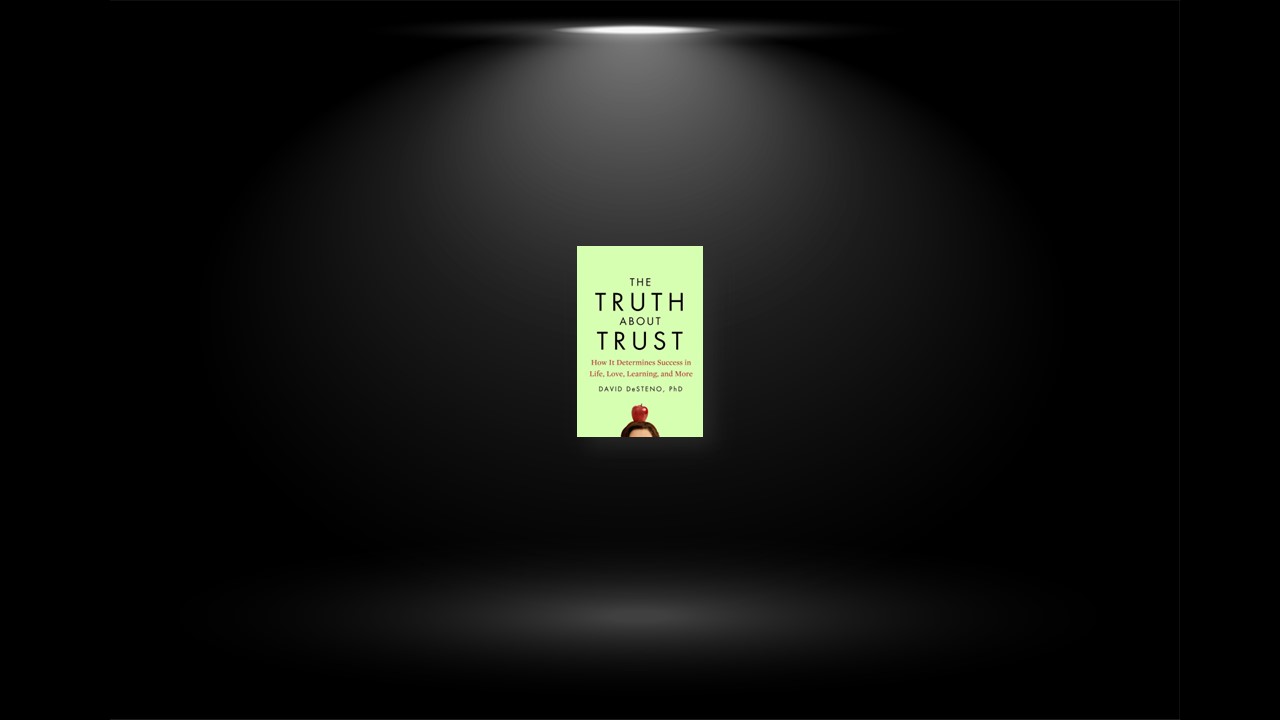FUNDAMENTALS
it’s not good versus evil; it’s the ant versus the grasshopper. The minds of most of us aren’t looking to cause others harm. Optimizing our outcomes—at least in a biological or evolutionary sense—is all about considering whether there are more benefits to be gained through short-term expediency or long-term perseverance and loyalty. Often, our rewards are greater if we can forestall immediate impulses and aggregate benefits over time. But then again, sometimes much is to be gained by taking the money and running, especially if we think we won’t get caught. These are the calculations that underlie trust—the calculations your mind is always making even without your awareness. To make better predictions, you should think carefully about why a distant reward seems less attractive. Is it truly not worth it to wait? Stop and calculate the potential gains from investing—both in money and people. Don’t simply go with your gut estimation of value by default; see if you can bring your reason and your intuition into consensus on what to do.
Everybody has their price, even if they don’t know it. We like to think that we can predict how people will behave based on reputation, but decades of findings show that this just isn’t the case. Consistency in trustworthiness comes from stable situations—situations where the costs and benefits don’t change very much. Once the nature of rewards is altered, all bets are off. And to make matters worse, we usually don’t even see it coming. Factors as subtle as emotional states, stress, or even the power of suggestion can significantly alter the calculations going on below a person’s consciousness and, thereby, tip the scales of trustworthiness.
Don’t be a statistic. Sure, mathematical models can suggest that always trusting others leads to better outcomes on average, but having odds for an average outcome isn’t what always drives success. Every individual mind is out to maximize its own resources, and that means always trying to discern two things: whether a potential partner can be trusted and whether he or she is likely to be encountered again. Answers to those two questions, far beyond anything else, will determine what any of us will be motivated to do in the moment. Recognizing this fact will help you realize why context matters—why you can’t possibly succeed by following a one-size-fits-all rule.
Look for competence. Nice guys don’t always know best. There are two facets to trust: integrity and competence. Some of the best partners or teachers you may ever have had may not be the warmest people in the world, but they knew their stuff. Yes, integrity is important in that you want others to be honest, but honesty buys little if expertise is lacking. A friend could believe he’s giving you good advice, but if he doesn’t have the requisite skills or knowledge, you’re going to end up failing if you trust him.
BUILT TO TRUST?
There’s a reason you have two sides. Maximizing outcomes in this world often requires flexibility. Issues of morality aside, much is to be gained by trust and trustworthiness, but certainly not all. Although it’s true that we profit by refusing to trust dishonest others, it’s also true that we sometimes profit by being untrustworthy ourselves. And while I’m certainly not advocating such behavior, overall success—not virtue—is what drives biological adaptation. As a result, we’re built to trust and deceive as a function of the risks and payoffs involved. Accepting this fact will not only allow you to come to terms with the biologically derived impulses you feel, but also prepare you to manage them as you see fit.
Trust is a force of nature. Dilemmas of trust aren’t particular to humans, and as a consequence, neither are the psychological mechanisms meant to address them. Our ancestors weren’t self-indulgent savages who only learned cooperation and loyalty through the development of civilization. As the behavior of many of our primate cousins shows, mechanisms to manage one’s trustworthiness and to read it in others derive from the conflicting pressures posed by social living.
Social mammals—humans included—find it difficult to trust or bond unless their physiology is in the right state (unless the stress comes from social anxiety and a related desire to bond and be accepted). This means having a high (but not too high) vagal tone, resulting in a sense of calm and certainty that allows communication and sharing with others. Nonetheless, the importance of a calm, assertive state for breeding trust should also raise red flags for you, as we’ve seen that feelings from one situation can sometimes bleed over to others, influencing how they are perceived. If you enter a new situation angry or nervous, you’ve already unwittingly constrained your ability to trust. Even if you normally might have trusted the person in front of you—and rightly so—those residual feelings decrease the odds that you will do so now. Similarly, if you enter a situation feeling exceedingly calm, you might just trust someone you shouldn’t. Both these facts point to the importance of understanding context. If you want to be able to trust as you should, take a moment before negotiating with someone new to allow any feelings from a previous event to dissipate.
IN THE BEGINNING
Telling kids to trust you doesn’t work. From nearly the moment they’re born, the minds of children begin to keep score with respect to whether an adult is trustworthy or not. Before they can speak, they know if you treat others fairly. And before they begin kindergarten, they know if you’re competent in certain areas. So, while you can try to convince their conscious minds to trust you, their nonconscious ones already know the deal. Past behavior, of course, never guarantees future behavior—reputation isn’t perfect—but it sets an expectation that you’ll have to work harder to overcome if you’ve let kids down in the past.
Instructors should be mentors, not friends. A good mentor is someone who holds the expertise to guide you in an endeavor and shepherds you through the challenges you face along the way. A good mentor, then, is someone you can trust both to support you and to give you expert advice, even if it’s not the advice you want to hear in the moment. For children, this means finding teachers whom they respect and like. But if they can’t find a teacher with both qualities, they tend to err on the side of respect. As we’ve seen, by the age of five, kids intuitively favor receiving information from people they view as experts over people they view as just nice. They also remember that information more, which can make all the difference when it comes exam time.
When it comes to being trustworthy, children are no less complex than adults. People often assume that kids’ decisions about how to behave are simplistic. If they want a cookie they’re not supposed to have, they take it and worry about consequences later. But in reality, their minds, at least at the intuitive level, are subject to the same competing mechanisms as ours. They recognize inequity at the same time they want to maximize their own rewards. They want others to view them as trustworthy, but also understand the benefits of anonymity. So, although they may split cookies evenly with a friend if she’s present, it’s also likely they’ll take more cookies for themselves if she’s not and unlikely to find out. Their minds, like ours, are trying to find the right balance between immediate and long-term reward. Unlike ours, however, it’s often more difficult for kids to override their intuitive impulses, meaning next time little Johnny says he doesn’t know why he broke a promise, he may really be telling the truth.
CAN I TRUST YOU?
The whole is more than the sum of its parts. The accuracy in detecting trustworthiness comes from looking for cues in sets—cues that, taken as a whole, express a more general representation, or gestalt, of a partner’s internal motivations and thoughts. Looking for the clichéd “shifty eyes” or similar “tells” will tell you nothing. So don’t fall prey to supposedly validated tactics that identify the untrustworthy by using single markers or micro-expressions.
Context is everything. Goals matter. Your mind intuitively shifts from using signals of affiliation and integrity to using signals of competence to determine trustworthiness as needed. It all depends on whether your goal in finding someone to trust involves needing a partner with honesty or expertise. This basic fact explains why you might at times feel differently about trusting the same person. For example, you might not want to trust a new college roommate with your money but still have a hunch you can rely on her advice when it comes to calculus.
Trust your gut, but not blindly. No one in our experiments possessed insight into the actual cues their minds were using to assess partners. Nevertheless, their minds utilized the four cues we identified to good avail, giving those who were able to see their partners greater accuracy in predicting trustworthiness than to those who had no face-to-face contact. What this means is your intuitive mind possesses some knowledge that your conscious one doesn’t (at least until now). It also has much more practice in using this knowledge.
The upshot is not to disregard your hunches as some irrational feeling or intuition, but to give them serious consideration. Consideration, however, means just that; it doesn’t mean blind allegiance. As intuitions can go awry, especially when psychological mechanisms that were honed in one environment or for one purpose begin to process information of a different type. So when your intuitions tell you something based on a photograph or slightly surprising face (e.g., very baby-faced or one having been altered due to accident or injury), take a moment to think whether your initial gut response may be a bit misguided.
Practice works, for humans and machines. Now that you possess some knowledge about what cues do matter, practicing looking for them should allow your conscious mind to catch up to your unconscious one. And when that happens, your ability to detect dishonesty and expertise should move beyond the baselines we’ve seen. But looking for patterns (patterns of cues in this case) isn’t something that only humans can do. Computers are even better. In fact, Jin Joo Lee of MIT’s Personal Robots Group has shown that automated systems can be trained to classify sets of cues and use the resulting information to predict trustworthy behavior with an accuracy much greater than that shown by humans. Now that we have a new way to identify the correct cues, its incorporation into technology should rapidly follow.


